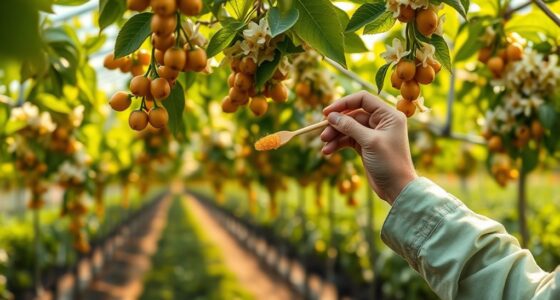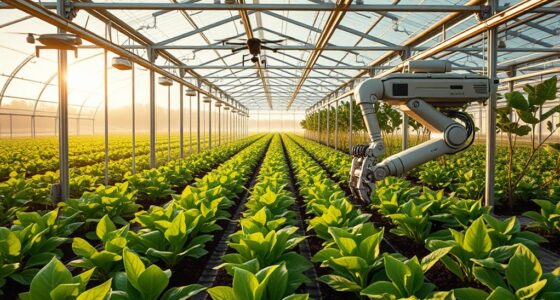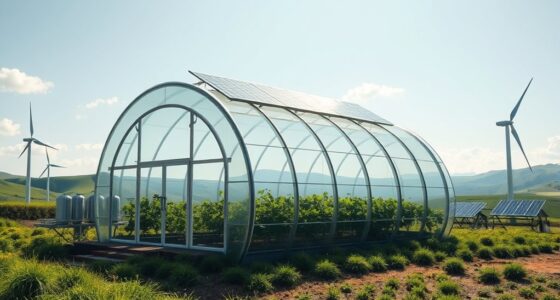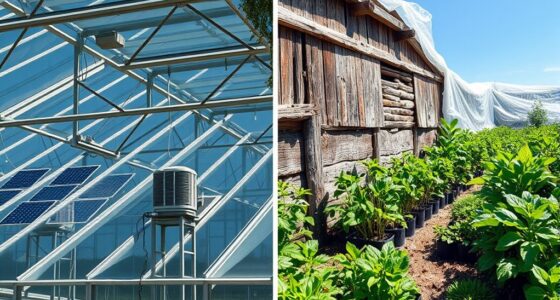Sustainable greenhouse farming faces challenges like high energy consumption, climate volatility, and water scarcity. Rising costs push you to adopt energy-efficient technologies, such as LED lighting and climate screens, while integrating renewable energy sources. Managing water through advanced irrigation techniques safeguards against scarcity. Disease and pest control require consistent monitoring and biosecurity measures. Economic factors add pressure, but strategic planning can help. Explore innovative solutions to tackle these issues and maximize your greenhouse’s potential.
Key Takeaways
- Rising energy costs require greenhouses to adopt energy-efficient technologies like LED lighting and climate screens to optimize consumption.
- Climate volatility necessitates controlled environments in greenhouses to mitigate the effects of extreme weather on crop production.
- Implementing advanced irrigation techniques, such as drip systems and rainwater harvesting, helps conserve water and reduce reliance on external sources.
- Disease and pest management can be improved through biosecurity measures, regular inspections, and natural control methods to maintain plant health.
- Economic challenges, including labor costs and market volatility, demand proactive financial planning and adaptability in greenhouse operations.
Energy Consumption Challenges in Greenhouse Farming
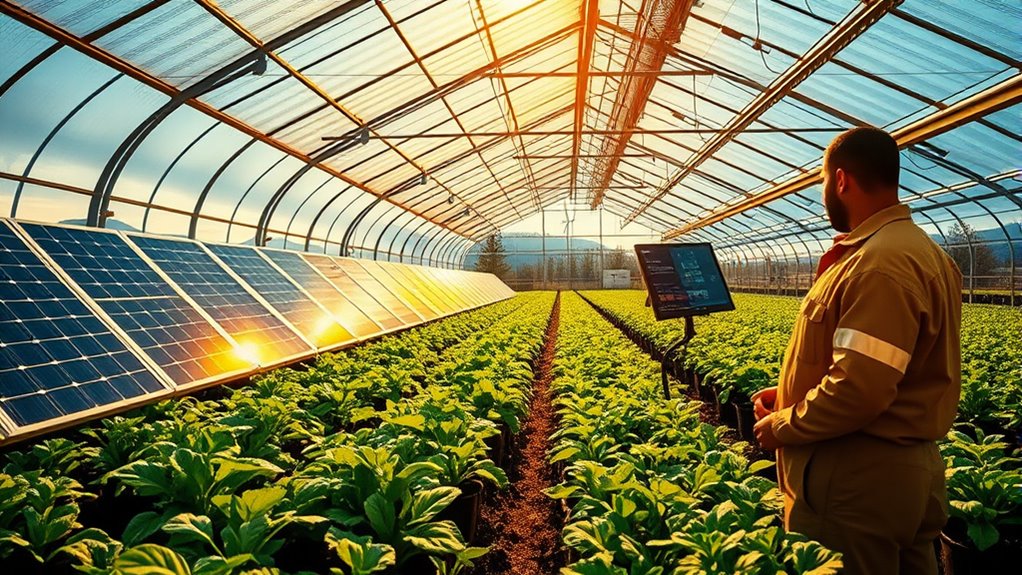
As energy costs continue to rise, greenhouse farmers face significant challenges in managing their energy consumption effectively. With heating accounting for 70 to 80% of total energy use, it’s essential to find ways to cut those costs. You might feel the pressure from rising energy prices while retail prices decline, making efficiency a priority. Your geographic location, greenhouse design, and crop selection all influence energy demands, so consider these factors carefully. Implementing energy-efficient technologies like LED lighting and climate screens can help optimize consumption. Additionally, integrating renewable energy technologies can reduce dependence on fossil fuels. Utilizing geothermal heat pumps can further enhance energy efficiency by leveraging the Earth’s stable temperature for heating and cooling, ultimately reducing energy costs in greenhouse operations. Furthermore, adopting energy efficiency ratings can guide farmers in selecting the most effective systems, ensuring maximum savings on energy bills. Moreover, understanding the refrigeration cycle involved in heat pumps can help farmers optimize their heating and cooling processes effectively.
Climate Volatility and Its Impact on Crop Production

Climate volatility poses significant challenges to crop production, often disrupting the delicate balance required for ideal growth.
You’ll face rising temperatures that can exceed favorable levels, leading to yield declines. Shifts in rainfall patterns can result in droughts or floods, harming crop health. While elevated CO2 might enhance photosynthesis, it often reduces nutritional quality. Extreme weather events can also lead to increased susceptibility to diseases and pests, further compromising crop yields. Additionally, balance bikes and scooters can promote physical activity, which is essential for maintaining health and resilience in farming communities. Primitive weapons can also play a role in sustainable practices by providing tools for pest management and crop protection.
Extreme weather events, like heatwaves and storms, can cause immediate damage. Additionally, regional variability means some areas benefit from climate changes, while others struggle. Greenhouses can provide controlled environments, allowing you to better manage these variations and protect your crops from climate extremes.
Adapting to these shifts is essential, and greenhouse farming can help create controlled environments, allowing you to mitigate some of these impacts.
Addressing Water Scarcity in Greenhouse Operations

Water scarcity in greenhouse operations presents a pressing challenge that requires immediate attention. To tackle this, you need efficient water management systems that minimize waste and optimize consumption. While current irrigation methods are effective, they still struggle with water loss through transpiration. Many greenhouses depend on external water sources, which can be unreliable during droughts. Implementing advanced technologies like drip irrigation systems and rainwater harvesting can considerably reduce your reliance on these sources. Additionally, using soil moisture sensors guarantees you water plants only as needed, preventing overuse. Greenhouses create an ideal microclimate that significantly reduces water evaporation and minimizes waste, further enhancing water conservation efforts. Furthermore, adopting sustainable forestry practices can provide a renewable source of biomass for energy and heating, aligning with eco-friendly principles. Moreover, integrating solar charge controllers into your greenhouse’s energy systems can optimize the use of renewable energy sources, supporting sustainable operations. Utilizing solar-powered irrigation systems can also enhance crop yields and improve efficiency, further addressing the challenges of water scarcity.
Disease and Pest Management in Controlled Environments
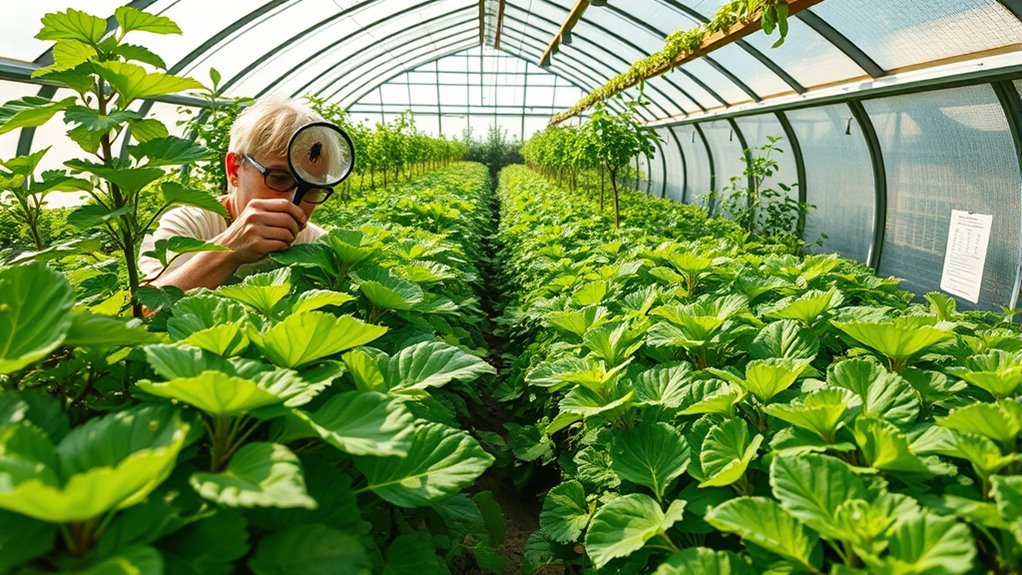
Effective disease and pest management in controlled environments is essential for ensuring healthy crops and maximizing yields. Start by inspecting and quarantining plants to prevent infestations. Maintain cleanliness and good ventilation, and use biosecurity measures like insect screens to keep pests out. Opt for disease-free planting material to minimize risk. Regular scouting with tools such as sticky cards helps you detect issues early. Additionally, cultivating chia seeds can offer natural resilience due to their minimal pest issues. Cacao’s health benefits include antioxidants that can enhance plant growth when integrated into the ecosystem. A well-rounded approach includes understanding market research to identify which crops are most resilient in your region.
Consider biological control methods like beneficial insects and predatory mites to manage pests naturally. Implement cultural practices, including crop rotation and proper plant spacing, to reduce disease spread. Monitor environmental conditions to support plant health and create a balanced ecosystem in your greenhouse.
While chemical pesticides should be a last resort, targeted applications can be effective when necessary. Integrating these strategies into your pest management plan creates a sustainable approach to greenhouse farming.
Overcoming Technological Integration Barriers

Although integrating technology into greenhouse farming presents several challenges, overcoming these barriers is essential for enhancing productivity and sustainability.
Integrating technology in greenhouse farming is challenging but crucial for boosting productivity and sustainability.
You’ll encounter diverse data sources and varying formats that complicate integration. The sheer volume of data generated demands sophisticated tools for effective analysis. To tackle these issues, consider using integration platforms or middleware that serve as translators between systems. Integrated data from various sources enhances agricultural production efficiency, leading to improved resource utilization and higher crop yields. Additionally, implementing cloud computing can facilitate access to real-time data, enhancing decision-making processes. As an example, utilizing low light office plants in greenhouse environments can help create a more sustainable ecosystem. Incorporating high omega-3 content from plant-based sources, like chia seeds, can also support a more sustainable and nutritious food system.
Cloud computing can provide scalable resources, while AI and machine learning help extract insights from raw data. Establishing data exchange standards is critical for seamless compatibility.
Start with gradual implementation—focus on one area, like soil moisture monitoring, before expanding your system. Protecting data security and ensuring quality is fundamental for informed decision-making, so prioritize these aspects in your integration efforts.
Strategies for Enhancing Energy Efficiency
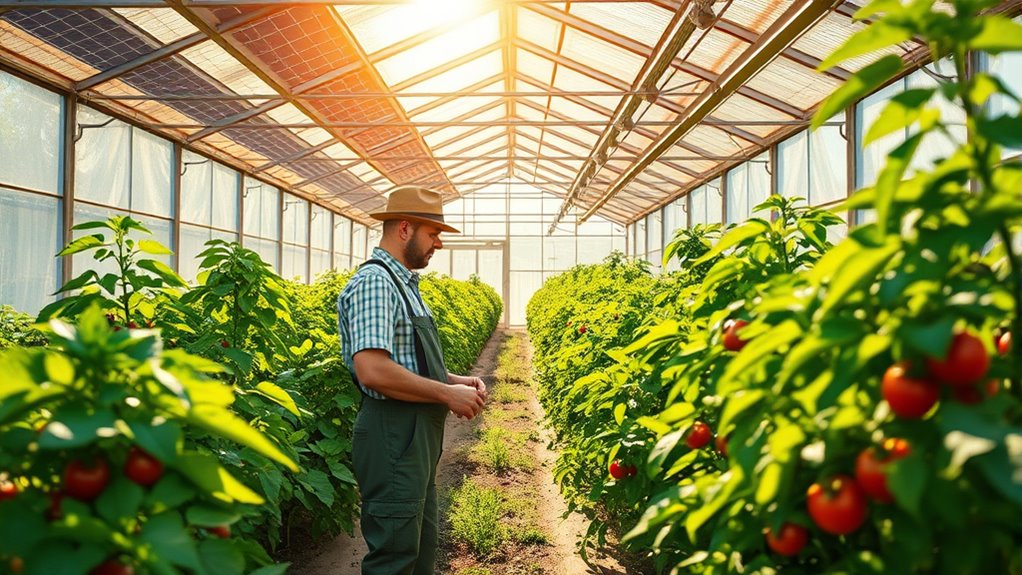
To enhance energy efficiency in greenhouse farming, you can implement a variety of innovative strategies that not only reduce costs but also promote sustainability.
Start by integrating renewable energy sources like solar panels and wind turbines to lower your reliance on fossil fuels. Hydrogen can be produced from renewable energy sources like wind and solar, offering a sustainable alternative to fossil fuels. Improve insulation and design to minimize heating and cooling needs. Utilize thermal screens to retain heat in winter and reflect it in summer. Many greenhouse structures can benefit from proper sealing mechanisms that enhance insulation and maintain optimal temperatures.
Focus on efficient ventilation by sealing gaps and using high-efficiency fans. Regular energy audits help identify areas for improvement.
Consider heating innovations like heat pumps and geothermal systems for long-term savings, as regular maintenance can significantly enhance their efficiency. Finally, automate climate control and use sensor technology to optimize conditions, ensuring your greenhouse runs efficiently while boosting productivity. This aligns with the need for resource-efficient agricultural practices to combat the challenges posed by climate change.
Innovative Technologies Transforming Greenhouse Farming

As greenhouse farming evolves, innovative technologies are revolutionizing how you cultivate crops, making it more efficient and sustainable.
High-efficiency LED lighting systems consume up to 40% less energy, providing ideal spectral output that can increase crop yields by 15-25%. These lights also reduce heat emission, allowing closer placement to plants, which enhances density and lowers water use. Additionally, incorporating heat pumps can further improve energy efficiency and indoor air quality in greenhouse environments.
AI-driven climate control systems enhance temperature and humidity, ensuring uniform growing conditions, while predictive maintenance keeps operations smooth. Incorporating renewable energy sources like solar panels further reduces operational costs and environmental impact. This shift towards renewable energy technologies not only supports sustainability but also enhances energy efficiency in farming practices.
Automation, through robotic harvesters and smart irrigation, cuts labor costs and delivers precise nutrients.
Hydroponic and vertical farming systems conserve water and increase yields by 30-50%, making your greenhouse farming more productive and environmentally friendly.
Water Conservation Techniques for Sustainable Practices
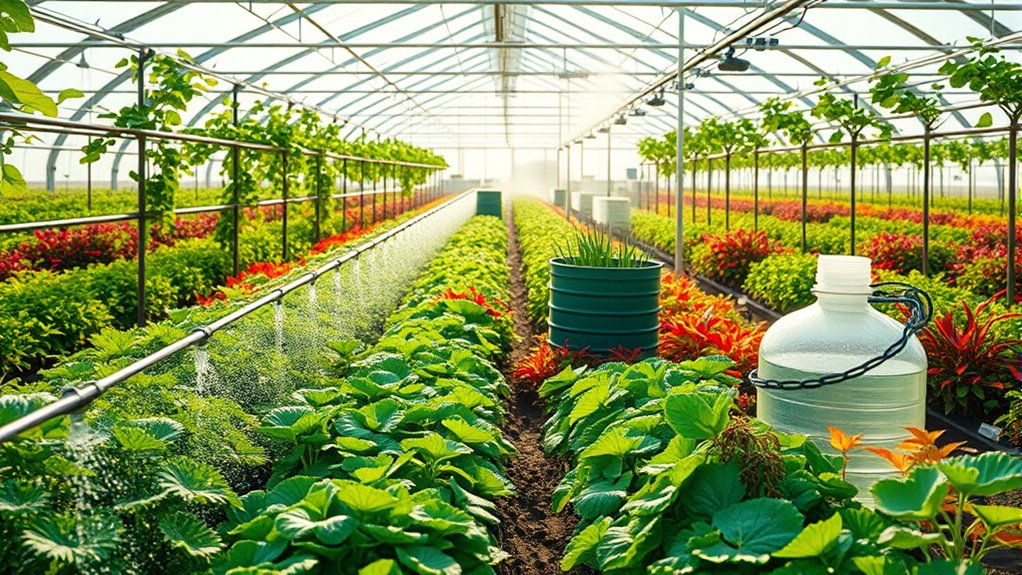
Water conservation techniques are essential for ensuring sustainable greenhouse farming practices, especially as water scarcity becomes a growing concern. You can implement precision irrigation methods like drip systems, delivering water directly to plant roots while minimizing evaporation and runoff. By creating a controlled microclimate in your greenhouse, you can reduce water vapor loss considerably. Additionally, higher humidity levels in greenhouses contribute to maintaining moisture for plant growth, further enhancing water conservation.
Consider recycling and reusing water through closed-loop systems, and don’t forget to collect rainwater to lessen your reliance on external sources. Monitoring soil moisture with sensors helps you optimize irrigation schedules, preventing overwatering.
Additionally, using shading mechanisms, mulching, and selecting drought-resistant plants can further enhance your water conservation efforts, allowing you to achieve higher yields with less water.
Economic and Market Challenges Facing Greenhouse Farmers
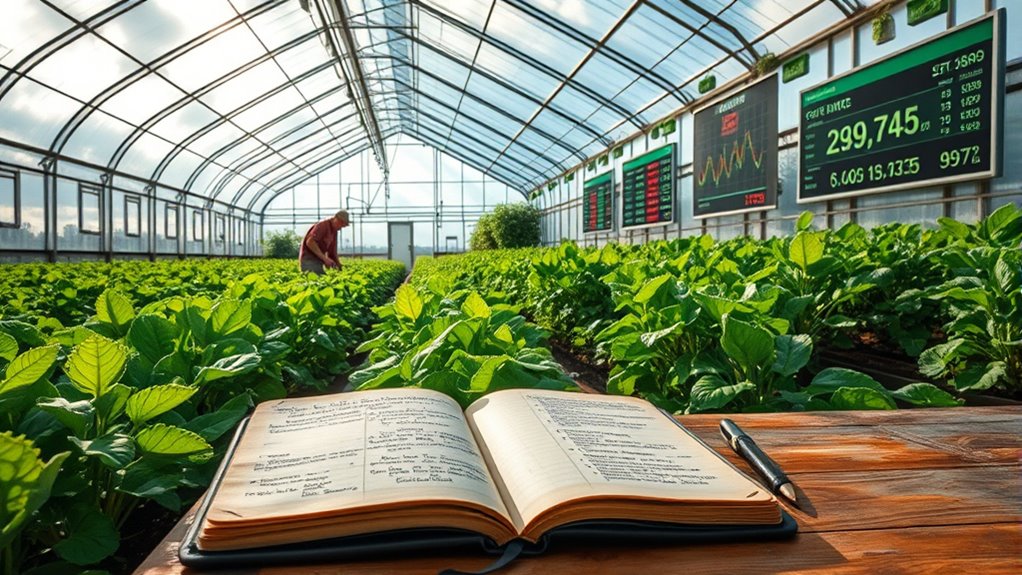
Implementing effective water conservation techniques is just one aspect of the complex landscape that greenhouse farmers navigate today.
You face economic uncertainties, including market volatility that directly impacts your profitability. High initial investments and rising production costs, particularly for energy and labor, can be intimidating. With 46% of greenhouse businesses reporting labor costs as a concern, finding skilled workers becomes vital. Additionally, higher yield from optimal growing conditions can help offset some of the rising production costs, making it essential to focus on maximizing productivity.
Additionally, market fluctuations and shifting consumer preferences demand your attention. Adapting to regulatory changes and ensuring supply chain resilience are equally essential for long-term success.
To thrive, proactive financial planning and diversification strategies can help you mitigate these challenges, while embracing technology and forming strategic partnerships will enhance your operational efficiency and market relevance.
Frequently Asked Questions
What Are the Best Crops for Sustainable Greenhouse Farming?
When considering the best crops for sustainable greenhouse farming, think about year-round options like lettuce, microgreens, and Swiss chard, which thrive in various conditions.
You can also grow profitable crops like tomatoes and herbs, which are always in demand.
For cold-hardy choices, kale and carrots perform well during winter months.
Warm-season crops like cucumbers and peppers can flourish in your greenhouse, maximizing your yield and profits throughout the year.
How Can Greenhouse Farmers Ensure Biodiversity?
Think of your greenhouse as a vibrant orchestra, where every instrument plays an essential role.
To guarantee biodiversity, you’ll want to cultivate a variety of crops, inviting beneficial insects and pollinators to join the symphony.
Incorporate native plants to attract natural pest controllers, and create diverse habitats around your greenhouse.
What Role Does Consumer Education Play in Sustainable Practices?
Consumer education plays a vital role in promoting sustainable practices. When you understand the environmental impacts of your choices, you’re more likely to opt for sustainable products.
This awareness drives demand, supporting local farmers and encouraging efficient resource use. By advocating for policies that favor sustainability, you help shape a market that prioritizes the environment.
Engaging with workshops and community events enhances your knowledge, making a tangible difference in promoting sustainable practices.
How Can Greenhouses Adapt to Urban Environments?
Urban greenhouses can be your garden in the sky, transforming rooftops and backyards into thriving ecosystems.
By embracing designs like vertical and hydroponic systems, you maximize limited space while ensuring efficient water use.
Smart sensors and automated systems make it easier for you to monitor plant health and optimize growth conditions.
With these innovations, you create a sustainable food source right where you live, enhancing your community’s food security and green footprint.
What Are the Long-Term Benefits of Sustainable Greenhouse Farming?
Sustainable greenhouse farming offers you numerous long-term benefits.
You’ll see increased property value and higher yields, which translates to better crop quality and market prices.
Year-round production guarantees stable income streams and helps you secure long-term contracts.
Plus, you might benefit from government incentives that ease initial costs.
As you grow food throughout the year, you’ll also enjoy long-term savings on grocery bills while minimizing losses from weather and pests.
Conclusion
Maneuvering the landscape of sustainable greenhouse farming can feel like steering a ship through turbulent waters. Yet, by embracing innovative technologies, energy efficiency strategies, and effective water conservation techniques, you can chart a course toward success. While challenges like climate volatility and pest management may seem intimidating, remember that each obstacle is an opportunity for growth. Stay proactive, adapt, and you’ll cultivate not just crops, but a thriving, sustainable future for your greenhouse operations.



